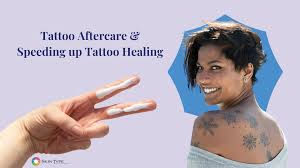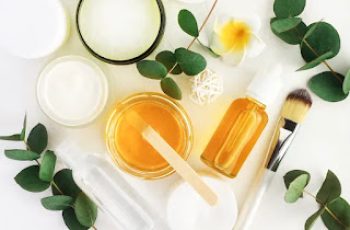
Tattoo Aftercare – How to heal tattoos faster
Getting a new tattoo is an exciting experience, but the tattoo aftercare that follows can be tedious. You may have left the tattoo parlor with limited instructions on how to keep it safe. The weeks that follow will require diligence to allow your fresh ink to heal properly. However, there are some safe ways to speed up the healing process without jeopardizing your new body art.
In this post, we’ll explore some best practices and products for tattoo aftercare that can accelerate healing and reduce discomfort, getting you to your fully healed tattoo faster.
While patience is key in the healing of any new tattoo, using the right aftercare methods can protect the integrity of your fresh ink while speeding things along. By following these tattoo aftercare tips, you can enjoy your new artwork sooner while avoiding discomfort or loss of color.
How long does it take for a tattoo to heal?
The time it takes a tattoo to heal will vary based on the size of the tattoo, the colors used, and how quickly your specific skin heals. (3) The typical timeframe I see in my dermatology practice is about 2-4 weeks of scabbing, redness, and peeling before the area is mostly normal. It can take a few months for the skin to heal completely. (4)
A small tattoo should heal faster than a large tattoo.
Because of the itchiness, scabbing, and peeling, there are some skin care products that can simplify the experience of tattoo aftercare.
Tattoo healing process
First, it is important to understand what is happening to your skin as it adapts to a new tattoo.
Your body is essentially reacting to repeated puncture wounds and the injection of foreign particles into your skin. (4)
The little holes made by the tattoo needle on your skin will bleed, scab, and heal like normal wounds. Meanwhile, the area encompassing your tattoo will peel and be red with inflammation as your body tries to remove dead skin cells through desquamation.
When your skin peels, there is an increased chance of barrier damage and dryness on the skin. (1,2)
If the area under and around your tattoo gets too dry or peels too much, the colors and borders of your tattoo can fade. Other causes of fading tattoo colors can be sun exposure and oxidation from exposure to oxygen without protective antioxidants.
Until it stops peeling and scabbing, your tattooed skin is very sensitive to sunlight. (4)
Similarly, new tattoos are sensitive to irritation from physical touch, which is why covering a tattoo with plastic wrap or stretchy bandages is so common.
Until your tattoos are completely healed, you need to take good care of them; this can mean getting good ointments, learning to treat scabs, and knowing what not to do.
Tattoo ointments
The most common products for tattoo aftercare are tattoo ointments. Ointments designed for wound healing, as is the case for tattoo aftercare, contain ingredients like growth factors. Growth factors and other similar ingredients stimulate healing and are often combined with moisturizing ingredients that help damaged skin tissues regenerate properly and quickly. (11,12)
Typically, you want an ointment that is antimicrobial, antioxidant, moisturizing, and/or pigment regulating. (5) Mineral oils are also very common for tattoo aftercare.
Here are just a few of our favorite ointments for tattoo healing:
[[PP15,PP16]]
Tattoo scabbing
Tattoo scabbing
One of the most frustrating parts of tattoo aftercare is the scabbing on and around the tattoo. Scabs can be so itchy and hard to leave alone, and when they get scratched, they can leave a scar behind. This is not even to mention that they can take on the same colors as the ink beneath them. Tattoo aftercare can be a strange process. Fortunately, there are things you can do to shed your black or blue scabs safer and better than scratching them.
Check out this blog on acne scabs where we take a deeper dive into the science of scabs.
When your tattoos are scabbing, it becomes extra important to keep them protected with some kind of cover like a bandage, a polyurethane wound dressing like Tegaderm, or plastic wrap. It is just as important to keep them clean with a good cleanser. Scabs are very likely to get infected.
Keep in mind that any random instance of increased friction can cause scabs to start bleeding- so be gentle! Wherever your new tattoo is located on your body, wear something to protect it.
When scabs are opened, they are more likely to catch infections which can lead to a variety of future annoyances and complications. (13)
Fortunately, there are some great cleansers great for the scabbing period of tattoo aftercare.
Products for Tattoo Scabs
The best products for tattoo scab healing are gentle cleansers with hydrating properties. Products like these below keep the skin moisturized while eliminating any potential causes of infection. The best gentle cleansers also soothe inflammation and redness associated with acne scabs.
Here are some of our favorite products for healing tattoo scabs:
[[PP14,PP19,PP28]]
what to avoid while your tattoo heals
What to avoid while your tattoo heals
While your tattoo is healing, there are a few basic things to avoid in order to make sure you get the best final result; for starters, avoid these ingredients and ingredient types: (1)
Ascorbic acid
Exfoliants
Glycolic acid
Low pH ingredients
Retinoids
Salicylic acid
Besides those ingredients, it is also important to avoid direct sunlight onto your new tattoo, because newly tattooed areas are photosensitive and can burn easily. (4)
You also want to avoid leaving the tattoo out in the open if it isn’t just black and white. Many pigments oxidize and change color in open air. This is a big reason to keep tattoos covered while they heal.
Additionally, try not to rub anything rough on your tattoos either, even if they’re itchy, until they’re fully healed.
If your skin is extremely sensitive, dry, or peeling, then avoid shaving the area if that is a concern.
Possible side-effects of tattoos
Tattoos are generally a safe practice. That being said, there are a few common notable concerns associated with getting tattoos.
New tattoos are susceptible to various bacterial and viral infections such as staphylococcus aureus and some kinds of hepatitis. (4) These microbes can come from needles at some tattoo parlors, or from general exposure to the environment.
It is important to mention that the FDA does not currently regulate pigments put into the skin for cosmetic purposes. Toxic compounds such as mercury and cinnabar have been found in commercially available tattoo ink. (14)
If you have an allergy to the components of your tattoo ink, or a sensitivity to toxins such as those two named above, getting a tattoo can lead to serious allergic reactions or toxification.
Be sure to ask your tattoo artist if they know the ingredients in their ink, and cross-check those with your allergies or level of risk aversion.
A new tattoo is a lot like an open wound from a dermatology perspective; you’re exposed to many of the same risks as a regular lesion. It’s important to use products that keep the damaged skin clean, moisturized, and to repair the skin barrier.
Exfoliants can mess up your tattoos
Exfoliants, or ingredients that speed up the desquamation of skin, should be avoided on new tattoos for at least a month after acquiring the tattoo (depending on the size and whether you’re still peeling). Exfoliants remove the outer layer of skin from the surface, which can interfere with pigments and even line structure in severe cases.
This means if you regularly use a retinoid on the same area where your new tattoo currently exists, you must avoid using that retinoid until the tattoo heals completely.
To find a new product to use while your tattoo heals, take our quiz for a custom recommendation!
Tattoo aftercare instructions
Even though the process might be tedious and sluggish, tattoo aftercare is actually a relatively simple ordeal.
There are a few simple steps you can take to keep your new tattoo from pestering you with inflammation, peeling, and scabbing. If you follow these steps, your tattoo will heal much faster and more painlessly.
Apply a gentle cleanser to the area
Use a healing, moisturizing ointment
Cover the affected area from direct sunlight
Avoid scratching or other random friction
Enjoy your day
After your evening shower, use another gentle cleanser
Use either evening moisturizer or ointment, depending on the ointment’s printed directions
Cover the area before going to sleep
As you can see, it is simple to speed up tattoo aftercare with just a few products and the right routine. Practicing these steps during your tattoo aftercare will help you heal quicker without messing with the pigments on your new body art.
The best tattoo aftercare products
As discussed above, the best way to speed up tattoo aftercare is with some protective practices and the right skin care products. These are some overall great product picks for tattoo aftercare that you can continue to use long after your body art has healed:
[[PP15,PP16,PP19,M43,C21]]
Shop by your Baumann Skin Type
Not every product is right for every person. Each of us has a specific skin type that can help us figure out which products to use if we know what our type is. If you are looking for the perfect regimen to get you through tattoo aftercare, take our quiz so you can look for your skin type octagon on every product page.


